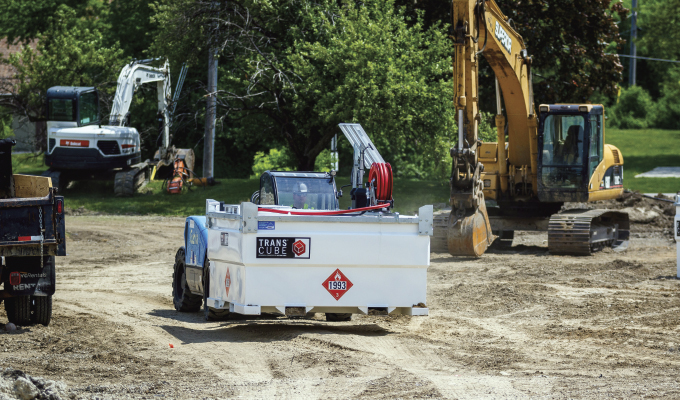Although wet hosing is a traditional solution for jobsite refueling, next-generation on-site fuel tanks provide many advantages for contractors looking to manage rising fuel costs and take control of their fuel supply. These tanks provide an efficient solution for everyday refueling and offer the ability to fuel a generator at a moment’s notice. On-site fuel tanks excel as response-ready solutions to quickly fuel multiple generators and bring energy to a site, including in emergency situations.
Let’s explore some common questions and considerations about on-site fuel tanks for everyday refueling and emergency preparedness situations.
Why should contractors consider on-site fuel tanks?
With the cost of fuel continuing to rise, on-site fuel tanks allow contractors to buy fuel in bulk to help mitigate costs. In addition to saving money, storing fuel on the jobsite adds a level of predictability because the fuel is available at a moment’s notice. With the current labor shortage affecting the nation, on-site fuel eliminates the stress and associated costs of relying on a driver for wet hosing. Plus, on-site fuel tanks increase safety for crew members by reducing traffic on the jobsite.
What on-site fuel tank features should contractors prioritize?
There are several types of on-site fuel tanks available, but there are a few features that contractors can prioritize to maximize ROI. One feature to look for in an on-site fuel tank is double-walled containment. Tanks with this design don’t require a secondary containment pan that takes time to set up. This means the tank is ready to go when it arrives. Double-walled containment also eliminates concerns about the secondary containment becoming filled with snow or ice and creating extra work to empty.
Convenience should also be considered. At Western Global, each of its TransCube Global tanks has pumps and accessories pre-installed to create a plug-and-play solution, even on hard-to-access sites. Some tanks require customers to source each component separately and assemble the system themselves. This added convenience means the fuel tank is ready to work immediately without setup time or specialized training.
Will my fuel supply be secure in an on-site tank?
Contractors should look for on-site fuel tanks that keep the pump and assets locked in a secure cabinet with card-lock dispense controls. This combats potential theft by only allowing authorized individuals to access the fuel. Since each card key is unique, the system also records which driver is taking fuel, along with refueling frequency and the amount of fuel used.
In addition to reducing the risk of theft, card locking systems allow contractors to track inventory levels at any time for complete control over their fuel supply. They can also help to determine overall efficiency or cost/price structures.
When should contractors consider a transportable fuel tank?
The more transportable the fuel tank, the more responsive it will be to evolving jobsite needs. Contractors should consider whether they will benefit from the ability to move the tank when it is still filled with fuel, such as with roadwork where the jobsite moves as work is completed. Traditional round tanks can be a hassle to move and set up but transportable fuel tanks like our TransCube Global come approved for transportation both around the jobsite and on the highway. This allows contractors to quickly move the tank to the most efficient location without the added time of draining the tank and setting it back up.
Forklifts or cranes already on the jobsite can easily move the Western Global transportable fuel tanks, minimizing the need for additional equipment and providing ease of transport. Our TransCube Global can also be hauled in the back of a truck or mounted on a trailer.
What are the benefits of using an on-site fuel tank to power generators?
On-site fuel tanks can serve a dual purpose to fuel construction equipment or a generator. In instances when a generator is needed on the jobsite, the on-site fuel tank can quickly adapt from fueling equipment to powering the generator. The generator can be connected to the fuel tank to extend run time, which means contractors won’t have to face the hassle of refueling the generator on a daily basis.
Contractors can also monitor the fuel tank remotely to be aware of its status and see when fuel is running low or if any issues arise. Tanks with remote monitoring systems transmit data to a browser or phone app, where contractors can generate specific reports to see the amount of fuel on hand (and the remaining capacity) as well as be alerted to abnormal level changes.
How long can a generator run with a fuel tank?
While generators average a run time of 24 hours on their own, pairing them with an on-site fuel tank increases that run time up to seven days. Our TransCube Global tanks take this benefit a step further with the ability to fuel up to three generators at once. This not only allows for quick response if unexpected problems come up, but also adds confidence for contractors to keep the job on track with a reliable power source.
CLOSING THOUGHT
Western Global tanks are designed to be prepared for any situation. Investing in on-site fuel tanks can help contractors manage the challenges of rising fuel costs and labor shortages while improving efficiency when fueling their fleet.
About the Author:
By Ken Steury is Western Global Americas Region director of sales. Western Global is a global designer and manufacturer of industry-leading tanks and equipment for fuel storage. Building on a legacy that spans five decades, Western Global offers a wide range of solutions for the safe transportation and storage of fuel. For more, visit www.western-global.com.
Modern Contractor Solutions, July 2022
Did you enjoy this article?
Subscribe to the FREE Digital Edition of Modern Contractor Solutions magazine.



